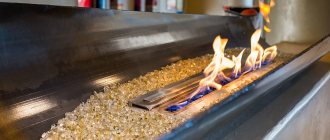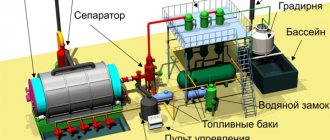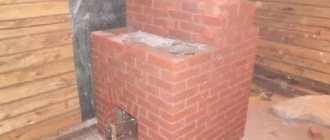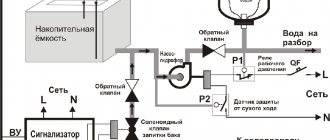Modern technologies are present in human life in all spheres. One of the newest solutions for the home is a bio-fireplace. These are fireplaces that run on biofuel. They have become a hit for modern style interiors. This type of stove is not only environmentally friendly, but above all, universal. It can be placed anywhere, even in an apartment building where it is impossible to install a traditional fireplace.
How to use a biofireplace correctly?
To avoid problems and disappointment, it is enough to follow simple rules.
Biofireplaces should only be installed on a flat, stable surface, especially those that use liquid fuel.
Fuel can only be poured into an extinguished fireplace; add only when the fireplace has completely cooled down and relight.
Install fireplaces with an open chamber away from flammable objects: bookshelves, windows with curtains, reception desks, etc.
Niches for built-in models should be equipped with special fireproof materials.
Light only using special means (lighter, control system).
Do not leave the fireplace unattended.
Do not allow children to light the fireplace or get close to it.
Do not place flammable objects on fireplaces.
Ventilate the room.
After use, it is better to drain the remaining fuel, especially if the fireplace will not be used for a long time.
Do I need to clean the bio fireplace? Yes, but it's a fairly simple job.
Biofireplaces for home
What types of biofireplaces are there?
Before buying a biofireplace, it is important to know how such fireplaces are classified. They are of the following types:
1. Wall-mounted. Such fireplaces benefit from saving free space in the room. They are mounted directly on the wall, similar to a TV.
2. Floor-standing. The most popular classic variations. Depending on the specific model and the dimensions of the room, they can be placed either on the floor near the wall or in the center of the room.
3. Tabletop. The smallest models of biofireplaces are tabletop. They are very small and light. Easily installed on any horizontal surface. Such as a table, window sill, chest of drawers, etc.
4. Built-in. Just like hanging ones, they benefit from saving space in the room. However, they require more complex installation. Built-in biofireplaces are installed in a pre-prepared and insulated niche in the wall. That is why the installation and installation of such fireboxes is desirable at the construction or renovation stage.
5. Corner. They are also installed on the floor near the wall, however, unlike floor-mounted ones, they are placed in a free corner. This advantageously saves joint space, allowing you to use a free corner. At the same time, the view of the firebox and fire will be excellent from different angles.
6. Street. Installed directly on the street. They can be placed either outdoors in the garden or in a gazebo or on the veranda.
In addition, modern biofireplaces can be automatic or mechanical. Mechanical ones are the most inexpensive and simplest models. They operate in manual mode and in order to adjust the height and power of the burning flame you need to use special levers on the body. Such mechanical biofireplaces consist of a body, a burner into which fuel is poured, and a special lever that opens and closes to ignite the fire and put out the fire.
For the manufacture of biofireplaces, only heat-resistant, durable and environmentally friendly materials are used. For example, the body itself and the fuel burner are made of stainless steel, which withstands strong heat and direct contact with fire. To decorate and additionally protect the hearth, transparent tempered glass is often used, which is extremely resistant not only to high temperatures, but also to sudden changes.
Automatic biofireplaces are more modern, innovative and functional models. They often operate from a standard electrical network and are additionally equipped with a remote control. Such models are very functional. They are complemented by different buttons and switches. Thanks to which you can set the required power, flame height, and program the fireplace to turn on and off independently.
Design and principle of operation of a biofireplace
The main difference between biofireplaces and their older brothers is the type of fuel used. Instead of ordinary firewood or charcoal, liquid fuel is used here. Most often this is bioethanol or liquids based on it (for example, denatured compounds with the addition of methanol). When alcohol burns, only carbon dioxide and water vapor that are safe for our body are released. Therefore, a biofireplace can be placed in an ordinary city apartment and does not require a hood. At least that's what the manufacturers say.
Liquid fuel is characterized by another feature - the complete absence of solid combustion products (unlike firewood, coal or pallets). Since ash and ashes do not form in the biofireplace, regular cleaning of the fireplace is not required. It is enough to simply wipe it from dust. There is also no caustic soot in the room. By the way, despite all the external harmlessness of an ordinary wood-burning fireplace, scientists warn about the health hazards of smoke from burning wood. So bio-fireplaces are preferable in this sense.
The design of the biofireplace is quite simple. The fuel combustion zone here is combined with the heat release zone. The main element is the combustion unit. Fuel is poured into it. For safety reasons, the tank is filled with a special porous material. This feature eliminates the risk of accidental fire or fuel spillage when the fireplace falls. A similar principle is used in gasoline lighters.
The tank is connected to several nozzles. The alcohol evaporates, rises and burns on these nozzles. Some models have only one burner located in the center. To regulate the flame intensity, biofireplaces are equipped with special dampers. By moving them, you can increase the fuel supply level, lower it, or completely shut it off.
An important design feature is the absence of a chimney. It's simply not needed here. Therefore, all other parts of the biofireplace perform a primarily decorative function. The combustion zone is fenced off from the outside space by a glass surface. A wide variety of materials are used for cladding - from alloy steel to granite and marble.
Biofireplace device
Its basis is a firebox, in which a stainless steel biofuel tank and special burners are mounted. When fuel burns, a bright and clean flame is formed that does not emit sparks, soot, soot or smoke. The combustion intensity is easily adjusted. The slider cover with which the heating unit is equipped is designed for this purpose.
It should be noted that the heating unit is easy to refill. Thanks to the “offset” filling system, it is convenient to add liquid fuel to it. This minimizes the risk of fires and burns. The heating block is made of two-millimeter stainless steel. Thanks to this (at high temperatures) it does not deform. It is important that the design of the block helps to reduce the return of the flame, and also eliminates the formation of the so-called “explosive cloud”.
The biofireplace is decorated and lined with fireproof glass, painted steel, granite, marble, veneer and other materials. As a result, a bio-fireplace can have the most incredible shapes, so that even professional decorators and lovers of the most extravagant interiors will like it.
Floor bio fireplace | Floor bio fireplace |
Glass floor biofireplace | Glass tabletop biofireplace |
Pros and cons of an interior item
The obvious advantage of such a fireplace is that it does not work on the principle of standard combustion and does not leave any traces behind. Therefore, it can be used in any room, even where installation of a standard device is impossible.
There is a long list of advantages of a biofireplace. They make it a unique building. These include:
- No installation or connection to the chimney is required.
- Can be installed in any room.
- There is a huge range of different shapes and sizes of fireplaces presented by manufacturers on the market. You can choose a device that fits perfectly into the interior.
- The risk of fire is reduced, if not to zero, then to a minimum. This is achieved through a unique fuel tank design.
- To install a bio-fireplace, you do not need to request permission or coordinate this issue with government authorities.
- Fairly simple installation process. All you need to do is bring it home and place it in the chosen location. Afterwards you can use it. But for large structures built into the wall, you will need the help of specialists.
- The product requires virtually no maintenance or care. It is enough just to wipe it from dust from time to time.
- Approximately 300-400 grams of fuel will be consumed per hour of non-stop operation. It depends on the size of the structure.
- Some may think that the cost of such an installation will be quite high. This is wrong. The price starts from 10 thousand rubles and even this is much cheaper than the simplest classical installation.
- Various aromatic oils can be used. Just one drop of such a substance can spread a pleasant smell throughout the entire room.
Advantages, disadvantages and features
The popularity of biofireplaces is understandable; they have a number of undeniable advantages.
Pros of biofireplaces:
- they can be installed in any house, apartment or office;
- there is no need to connect to the chimney and coordinate with the fire department;
- biofireplaces are easy to use, easy to light and extinguish;
- desktop models are mobile - they can be easily rearranged and even moved to another room;
- when burning biofuel, the fireplace does not emit harmful gases, soot, soot, and does not pollute the air and household items;
- A large selection of shapes, sizes and designs allows you to choose a bio-fireplace to suit every taste.
It should be remembered that when bioethanol burns, oxygen is absorbed from the air and carbon dioxide is released, so it is necessary to ventilate the room during its operation.
Owner reviews also point out the disadvantages of biofuel fireplaces :
- Unlike wood-burning, gas and electric fireplaces, a bio-fireplace cannot be used to heat a room; it produces little heat;
- the cost of the biofireplaces themselves and the liquid used for them is quite high and not everyone can afford it;
- Open flames and flammable liquids are potential sources of fire, so care must be taken when handling and storing biofuels.
Despite the disadvantages of using a biofuel fireplace, the advantages are still more significant, so owners of stylish apartments and houses are increasingly giving preference to them, despite the high price.
When installing stoves and boilers operating on solid fuel or gas, it is necessary to correctly select and install not only the unit itself, but also the chimney. We describe in detail how to do this with your own hands in this article. Here we give recommendations for effective chimney cleaning. How to act if reverse draft occurs - read here.
Biofuel in a biofireplace
It’s not difficult to understand how a biofireplace works, but what is fuel with the prefix “bio”? Eco-friendly fireplaces were born thanks to the discovery of bioethanol. Despite such a loud name, the substance is familiar: it is industrial alcohol, which is obtained from legumes, grain crops, potatoes, sugar cane or beets.
Fuel advantage
A fireplace fueled by bioethanol promises:
- absence of unpleasant odor, soot, soot;
- light aroma due to the use of special additives;
- no burning splashes or flying sparks;
- economical fuel consumption.
The process of producing ethanol, technical alcohol includes 3 stages. This:
- preliminary preparation of raw materials - grinding;
- then - fermentation using yeast;
- its filtration is the removal of solid biomass from a liquid.
The result is weak ethanol (15%), which is then distilled and concentrated. Additives are added to the resulting ethanol after these operations, turning a simple product into a biological one - bioethanol. Alcohols obtained from organic raw materials (bioethanol, biobutanol, biomethanol), as well as dimethyl ether, are biological and environmentally friendly fuels. When burned, such products release only a small amount of carbon dioxide and distilled water vapor.
Product percentage composition
Colorless and flammable fuel consists of 95% ethyl alcohol. The percentage of other additives looks like this:
- water - 4%;
- bitrex (denatonium benzoate) - 0.01%;
- methyl ethyl ketone (solvent) - 0.5%;
- additives for odor and color - 0.5%.
In its pure form, this alcohol is completely odorless, but some manufacturers add fragrances to its composition. Burning fuel may smell like birch wood, coffee, rosemary, pine needles, etc. Flavored fuel also requires good ventilation.
Other possible (used) additives are sea salt, due to which a crackling sound appears during the combustion process, like real firewood, and special additives that give the flames an orange color.
Bioethanol consumption
What is the biofuel consumption in a biofireplace? It all depends only on the length of the fuel block. For every meter of it, approximately one liter of bioethanol is needed. This volume is enough to keep the fire burning for one hour. Each next liter of fuel will be consumed faster.
The reason is the high temperature in the fuel block, which is responsible for faster heating and evaporation of bioethanol. Automatic models offer significant savings. It is guaranteed by special regimes. These fireplaces can burn for 3-4 hours after one refueling.
Since biofuel consumption in a biofireplace often becomes a decisive factor when choosing one model or another, this issue worries everyone. The answer can be found in the passport of a specific model, or on the fuel label. The average data is 360 ml per hour, so a liter of bioethanol can last for 2-3 hours or 5.
The technology for producing fuel for biofireplaces requires precise proportions. The entire process is very strictly controlled by manufacturers. Yes, you can make bioethanol yourself. But it is not necessary, since any amateur activity can lead to very sad consequences - for example, damage to the device.
Since the bio-fireplace works with fire, but without suffocating smoke, this design is a good opportunity to bring real, but almost tamed, elements into your apartment or house. The only stumbling block for future owners of this wonderful equipment may be the consumption of biofuel in the biofireplace, however, it seems that this is a small price to pay for the chance to contemplate a live fire at any time of the day.
You can get acquainted with the environmentally friendly device in absentia. If readers don't mind spending a little time on this video:
Was this article helpful? We want to improve. Thanks for your opinion!
Advantages of the model range
The relatively simple operating principle of the biofireplace adds the following advantages to it:
- The desktop biofireplace, like other models, does not require the installation of a chimney.
Such a device can be located in the living room or anywhere else in the apartment without any problems; Advantages of a biofireplace: does not require installation of a chimney - Aesthetic pleasure from live fire. No model of electric heating system will give you as much pleasure from heat as the Planika eco fireplace;
- Wide variety of shapes and designs. The biofireplace can be placed on the floor (floor-mounted) or hung on the wall (wall-mounted);
- Availability. A wide variety contributes to affordable prices. Biofireplaces such as “Prometheus”, “Planika” and all types with the prefix “Eco” are considered relatively inexpensive and worth the money.
An objective look at the device allows us to highlight several disadvantages:
- High cost of fuel. If you don’t know how much biofuel costs, then don’t rush to buy a biofireplace. Its use can cost a lot of money.
- Dangerous for children. In apartments where there are children, it is better not to purchase a tabletop biofireplace, since they can get burned while playing. If there is a bio-fireplace in the children’s room, then it is better to remove it from the house or prohibit children from approaching it.
Disadvantages of bokamin: high cost of fuel
How to choose
When choosing a biofireplace, you should pay attention to the following points:
- Power . Each model has its own power. This indicator directly determines how “hot” the fireplace will be. For a city apartment, the best option is low-power devices of 1 - 2 kW. If you take a “stronger” model, the room where it works will be hot.
- Fuel consumption . This parameter depends on many factors: power, operating mode, room temperature. Typically, low-power models consume from 250 to 400 ml of ethylene per hour. Options for gas fireplaces may vary.
- Burner material . Today, the most common burners are ceramic and steel. Steel ones are more expensive, but also last longer. Ceramic ones can crack or even collapse due to temperature changes. But in most cases they are enough for 4–5 years of active use.
After using the bio-fireplace, the room must be ventilated. If you do not do this, there will be too much carbon dioxide in the air inside the apartment, which can negatively affect your health. For example, excess CO2 can cause headaches.
It is also worth paying attention to the price and manufacturer. It’s not worth purchasing very cheap models. They can behave unpredictably, marriage is possible.
Before purchasing, be sure to read reviews about the model left by device owners. This will help you better understand the features of its operation in real conditions, as well as get an idea of possible problems.
Preparing to make a biofireplace
To make your own fireplace, you first need to decide on its type, take the necessary measurements, and make a sketch of the future model. This will allow you to avoid errors during work.
Materials and tools
You can make a bio-fireplace at home using ordinary glass, for example, from an A4 photo frame, a glass cutter, silicone sealant, metal mesh, a mesh from a barbecue or oven, a metal box, pebbles or other heat-resistant stone, fuel and wick.
Do-it-yourself desktop biofireplace
The stages of its construction are as follows:
- We calculate the distance between the burner and the protective screen. It should exceed 15 cm to avoid damage to the glass. We measure the distance between the burners - it should be more than 16 square meters. cm.
- Preparing the fuel tank. You can use a simple square or rectangular metal box, keeping in mind the distance from the flame to the glass.
- Painting the drawer to increase its aesthetics. It is carried out only from the outside, as fire or release of toxic substances from the paint applied to the inner surface is possible.
- Creation of a protective glass casing. It can be made from ordinary three-millimeter glass or 4 glasses from a photo frame, which are adjusted to fit the metal box.
- The glass is glued together with silicone sealant, secured between supports, which can be any stationary objects, and left in this state for a day until the sealant dries.
- Excess sealant is removed with a blade.
- Biofuel preparation. Only a metal can is suitable for storing it, even if it was sold in a plastic one. The jar is placed at the bottom of the box. One standard container of fuel will support combustion for several hours, after which it will need to be replaced - you will need to remove the stones and mesh or fill in a new portion with a large syringe.
- Cutting a mesh to cover the box. This can be done in two layers. Its fastening will be more reliable if you use wire, but do not forget that the mesh must be removed to replace the can of fuel.
- Laying stones on the grid. They are needed not only as a decorative element, but also for uniform heat distribution between the grille and the screen.
- Ignition of a biofireplace with a torch lowered through a mesh into a container with fuel.
Do-it-yourself floor biofireplace
To design a floor biofireplace you need:
- Prepare materials: a sheet of drywall, 2 square meters of thermal insulation material, 2 square meters of tiles with glue, 8-9 meters of metal profile, a hundred screws and self-tapping screws, grout, stones or other decorative elements, heating unit.
- Assembling the frame using screws and a metal profile.
- Sheathing the frame with plasterboard and self-tapping screws, two layers on each wall, between which glass wool or other thermal insulation will need to be placed.
- Facing with tiles or other similar material. To do this, you need to carefully lay it out in accordance with the idea; for example, the fireplace can be made monochromatic or a pattern can be added.
- Grouting joints.
- Drying.
- Installing the heating unit in its place.
DIY bio-fireplace burner
The most reliable material for a burner is stainless steel. Its walls should be thick enough to avoid deformation when heated. You should also be very careful when assembling, since unreliable fastening or a defect will damage the bio-fireplace.
It is advisable that the burner be solid, so there is less chance that fuel will spill out. A paint can is best suited for this role, the main thing is to make sure that its size is suitable for the fireplace and that there are no cracks or holes in it.
Those who are not looking for easy ways can make the burner completely themselves; it is not difficult, since in appearance it looks like a large matchbox with an oblong hole in the top for pouring biofuel. Sheets of metal 1.5-2 mm thick are welded at the seams. You can add glass wool to it, which acts as a wick, and a damper, which will regulate the flame and extinguish it.
The burner is ignited with an ordinary wick, for example, a cord dipped into biofuel, the end of which will rise above the stones or other decorative elements.
Fuel for biofireplace
Bioethanol can be used as a fuel; it is sold in specialized stores, but can also be made at home, since it consists of gasoline, which is used to fill lighters, and ordinary medical alcohol, mixed 1 to 9. After mixing and shaking, the mixture is suitable for use.
Video review
A biofireplace is a device that resembles a fireplace and is intended for installation in a city apartment. It usually uses ethyl alcohol or propane as fuel. The bio-fireplace does not need a hood – it is enough to ventilate the room after using it.
Today you can find a variety of models on the market - from budget to premium. You can buy a ready-made solution, or you can purchase a burner for independent integration into the interior. When choosing, you should pay attention to power, fuel tank capacity, material of manufacture, price and manufacturer.
There are many myths around biofireplaces for apartments.
These myths can be both positive and negative. We have several plausible assumptions that we could make over the years of working in this market:
- Incorrect information is provided by non-specialized fireplace stores. This is quite understandable, because such stores may have thousands of items, and sales consultants cannot know enough information about each product or even a group of products.
- Unscrupulous and short-sighted bio-fireplace stores lie. This situation can be seen especially often among new players in the market; they want to get a client by hook or by crook, or they simply do not understand the issue.
- Reviews from people who suddenly saw a biofireplace in operation somewhere (at an exhibition and from friends, etc.) In such a situation, people often tend to speculate and draw incorrect conclusions.
- Incorrect use of a biofuel fireplace and, accordingly, negative feedback about the work.
- Rumors and speculation based on incorrect information from popular sources. As a rule, such toxic sources can be television programs or popular Internet portals where copywriters have not spent enough time studying the materials.
general information
The biofireplace is a simple system, the basis of which is the combustion of liquid fuel, bioethanol. Biological fuel is nothing more than natural alcohol, so when burned, only steam and a small part of carbon dioxide are released. Pure alcohol burns with a blue flame, but a yellow fire should blaze in a fireplace, so bioethanol contains various additives that add realism to the fire.
Let us note that it is important not only that a homemade bio-fireplace is easy to manufacture, but also that for its operation it does not require the installation of a chimney, an exhaust hood, or the installation of engineering systems and communications. All that is needed for the full operation of the system is regular ventilation of the room to supply fresh air saturated with oxygen. After all, as you probably know, oxygen is actively used in the combustion process of alcohol fuel
After all, as you probably know, oxygen is actively used in the combustion process of alcohol fuel.
Modest biological fireplace
Despite the fact that the operating principle and design of a biofireplace are always the same, there are a large number of different variations in the design of this device. Most often you can find the following varieties in stores:
- Floor-standing options can be installed along the wall or designed to be placed in the corner of the room. These systems can be large or small in size, allowing the bio-fireplace to be moved anywhere in the room.
- Hanging and built-in options have more modest dimensions. Such eco-fireplaces are hung on walls or mounted in special niches prepared in advance for these purposes. An interesting point is that such devices are fixed both in walls and in furniture, for example, in cabinets, on coffee tables.
- Desktop options are miniature versions. These decorative devices will fit perfectly on your table, shelf or nightstand. The easiest way to make a desktop biofireplace yourself is to fully evaluate how such devices work.
Tabletop variation on the biofireplace theme
Regardless of which biofireplace design is chosen, factory models usually provide the ability to adjust the height and pressure of the flame. If you make it yourself, this can be done by working with burners.
(19
ratings, average:
4.13
out of 5)
To create a warm and cozy atmosphere in the house, people often buy bio-fireplaces, which are placed in the rooms of city apartments without taking up much space.
Eco fireplaces are in great demand due to their ease of operation and the use of environmentally friendly fuel, which is very important for small-sized residential premises. The growing production of biofireplaces contributes to a wide range of designs, differing in size, material and type of installation. Although the price for them is acceptable for people of average income, such a pleasure still remains expensive for many
What should you do if you want to add a touch of comfort to your home with an attractive heating tool?
Although the price for them is acceptable for people of average income, such a pleasure still remains expensive for many. What to do if you want to add a touch of comfort to your home with an attractive heating tool
?
The way out is to create a bio-fireplace with your own hands
. Making a fireplace will not be difficult if you know the main components of the device and manufacturing technology.
Instructions for assembling a large bio-fireplace
If you need to make a large bio-fireplace, the most difficult part will be making the fuel tank. The easiest way is to purchase a ready-made element in a specialized store.
If you plan to make the tank yourself, you need to take a sheet of metal more than 3 mm thick. It must be stainless steel, otherwise during combustion there may be unwanted chemical reactions and even the appearance of toxic fumes.
Specialized stores sell fuel tanks for biofireplaces made of stainless steel. They are equipped with convenient fire extinguishing valves
The tank itself should consist of two compartments. The lower one is for filling fuel. Vapors of flammable liquid burn in the upper compartment. Between these compartments there should be a separating plate with holes, thanks to which vapors enter the combustion zone. The shape of the tank may be different, depending on the fireplace model.
The most popular option is a parallelepiped-shaped fuel tank with a narrow upper compartment.
It is easier to make a cylindrical tank. To do this, you can take an ordinary mug and cover it with a lid cut to size from a fine-mesh metal mesh. Fuel can be poured through the mesh, which is quite convenient.
There may be several such tank mugs in the design of a biofireplace. They can be arranged in several rows or in a circle
It is important not to forget to remove the handles from the mugs. This must be done carefully so that a hole does not form.
Having decided on the fuel tank, you can start making a bio-fireplace. Let's make a floor model with two glass screens. To work, you need to prepare fire-resistant glass for screens, a fuel tank in the shape of a parallelepiped, washers, bolts and silicone gaskets for glass, plastic or metal legs.
In addition, to make the base we will need thick plywood or plasterboard, screws and 40x30 mm wood blocks.
Let's start from the foundation. We mark a sheet of plywood and carefully cut out the side parts of the base box and the top panel from it. We will not make the lower part of the box.
Firstly, its presence will significantly make the structure heavier. Secondly, it will be much more convenient to secure glass sheets without it. We are preparing two pieces of wooden block onto which the plywood will be attached.
You can make a bio-fireplace with two glass screens yourself. The design of the base can be very different - in the form of a console, table, box
On a panel cut from plywood we mark the place where the fuel tank will be fixed. Cut out the required mounting hole for the tank. Now we assemble the frame and attach the top panel to it. We process the edges of the structure well.
If we used drywall rather than plywood, its edges must be treated with putty. We decorate the resulting base in any suitable way: paint, varnish, etc.
Preparing glass panels. First, cut out two parts of the desired size. In each of them you need to drill holes for decorative fasteners. This is quite difficult, because the slightest mistake can cause the glass to crack. If you have no experience in such work, it is better to entrust the process to an experienced craftsman with a set of special tools. Holes for fasteners are also drilled on the side walls of the base.
Now we fix the glass screen to the base. To do this, we pass a bolt through the glass, do not forget to put on a silicone gasket so as not to damage the glass. Pass the bolt through the base, put on the washer and tighten the nut
This must be done extremely carefully, without applying excessive force, otherwise the glass may crack. This is how we install both glass screens
During the assembly process, silicone gaskets must be used, otherwise the glass may not withstand the load and crack. It is wise to use a more durable option - tempered glass
You need to place legs on the bottom of the glass sheet. To do this, we put rubber gaskets into the parts and put them in place. We check the correct installation of the legs. The biofireplace should stand level and not wobble.
Using the prepared hole, we mount the fuel tank and securely fasten it. The structure is almost ready. All that remains is to decorate it with stones or ceramic logs, if necessary.
What are biofireplaces made of and what are they used for?
An ordinary classic brick fireplace is needed for heating the room, cooking and for interior aesthetics. The biofireplace performs the following tasks:
- serves as an interior solution;
- its power is capable of replacing an electric heater of 3000 watts;
- capable of humidifying the air;
- used in aromatherapy.
Biofireplaces consist of the following parts:
- deflector - a means of supplying hot air to the apartment;
- glass door so you can look into the fire;
- body made of wood, stone or glass;
- a heating unit, which includes a nozzle and a fuel container;
- a damper with which the height of the fire is adjusted.
In addition, the design also has auxiliary elements:
- mug;
- base;
- glass cylinder;
- plate.
How to make a floor structure
The floor design fits into any interior, as it imitates wood-burning fireplaces
The advantage of floor-standing biofireplaces is their variety of shapes and sizes. They can resemble a geometric figure, a bowl or a cabinet, and remain stationary or mobile. But the heating block for them must be made of metal. The body itself can be made of stone, wood, plastic, ceramics or plasterboard. The main thing is to ensure that the fire does not affect flammable elements.
Required materials and tools
- heating unit;
- non-flammable drywall (1 sheet);
- metal profile with guides and rack elements (8 - 9 m);
- dowel-nails, screws for metal and with a countersunk head;
- heat-resistant tile adhesive, putty;
- metal scissors, screwdriver, knife for cutting drywall;
- insulating materials (2 sq.m);
- ceramic tile;
- grout (about 2 kg);
- building level, tape measure;
- wood or other material for the mantel;
- decor for decorating a finished bio-fireplace.
All calculations must be made taking into account the size of the space for the future bio-fireplace. One of the options is shown in the drawing.
Preparatory work
The drawing must be created taking into account fire safety. This option provides for the arrangement of a firebox
At this stage, you need to decide on the size and design of the biofireplace: large or small, wall-mounted, corner or located in the center of the room. After this, a drawing or sketch is created taking into account the fire safety of the object. When calculating its dimensions, you need to ensure that the distance from the hearth to the walls of the structure and the mantelpiece is at least 15 - 20 cm. After this, based on the drawing, markings are applied to the wall and floor.
Step-by-step manufacturing instructions
The process involves several stages: from fastening the profile to decorating the sheathed drywall
- Frame assembly. According to the finished markings, pre-prepared guide profiles are attached. Then rack elements are inserted into them, which are subsequently secured with self-tapping screws. Verticality is controlled using a plumb line.
- Fastening profiles to the wall using dowels and nails. In this case, the racks are additionally secured with jumpers.
- Laying insulating material into the walls of a structure. They can use compressed basalt wool.
- Plasterboard sheathing. To do this, you need to mark the sheets of drywall and cut off unnecessary elements using a special knife. The main thing is to make an incision on one side, breaking the material on the other. When covering the future structure, you need to screw in the screws at a distance of 10 - 15 cm from each other. Upon completion of this work, gypsum plaster should be applied.
- Bio fireplace finishing. To do this, the walls and bottom of the housing are covered with ceramic tiles, with the exception of the recess for installing the burner.
- Grouting joints. After it, the mantelpiece is installed, and the structure itself is decorated with prepared decorative elements - stucco molding, mosaics, facing bricks.
- Burner installation. You can purchase it or make it yourself from a metal glass in which the wick is lowered. In the latter case, you won’t be able to adjust the flame height, but you won’t have to pay for a factory design.
The final stage may be the installation of a forged or fireplace grille made of heat-resistant glass, which will provide an additional level of safety for household members.
Due to the bulkiness of floor-mounted biofireplaces, they are often designed in the form of corner structures. The latter can be symmetrical or asymmetrical, when a column is installed instead of one of the back walls near the fireplace. Their installation is practically no different from the installation of standard floor biofireplaces, with the exception of the drawing.
How is a biofireplace installed?
The method of installing a biofocus primarily depends on its design. If you purchased a portable floor model, then you should assemble it in accordance with the instructions and start using it. Make sure that the room where such a fireplace will burn has sufficient air flow and corresponds to the specified area for a particular fireplace.
For built-in models, installation is more difficult. If there is a suitable niche in the room, then you are lucky, you can install a fireplace directly into the wall. But if there is no niche, then you can install a bio-fireplace in plasterboard, or rather a portal made of plasterboard or gypsum fiber board. GVL is a non-flammable material, so constructing a portal from it is absolutely safe.
To ensure that the installation of the bio-fireplace goes smoothly, first assemble it completely. This will help you take the correct measurements for making the case. Some built-in models include platbands in addition to fire-resistant glass. For their correct installation, clear markings are required. If there are no platbands, then the body can be covered with stucco, decorative stones, brickwork, etc.
Installing a bio-fireplace in a cabinet is another installation method. In this case, the body of the bio-fireplace is mounted directly into the countertop of the cabinet, that is, on its surface. Considering that a biofireplace produces a large amount of heat, such a cabinet will have a special device. If you make a countertop from traditional materials, then due to the heat they will rise very quickly, and it is also unsafe. The surface of the cabinet where the hearth is built in should be made of metal. The metal body of the eco-hearth itself also needs to be thermally insulated. In this case, there is no need to lay out thermal insulation over the entire cabinet; just cover the box under the bio-fireplace.
Installation rules:
- Do not place the bio-fireplace close to the wall. The distance from the glass to the wall should be at least 2 cm.
- The hanging fireplace is mounted at least 0.3 meters from the floor, and the distance to the ceiling must be at least 1 meter.
- When installing the fireplace, use a level; it is important that it is level, otherwise it may affect its operation.











